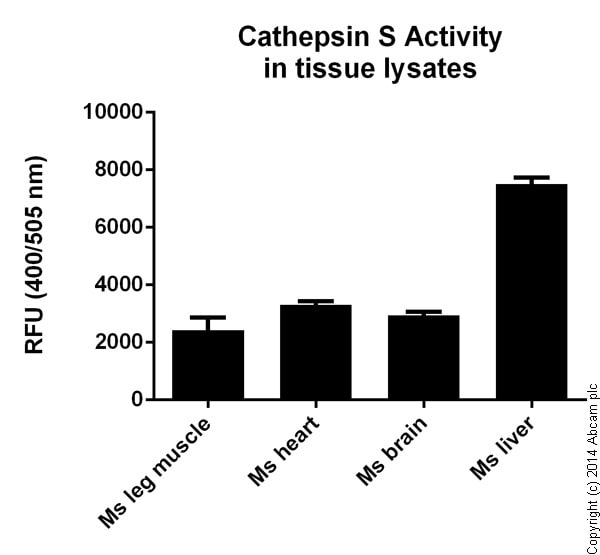Cathepsin S Activity Assay Kit (Fluorometric) (ab65307)
Key features and details
- Assay type: Enzyme activity
- Detection method: Fluorescent
- Platform: Microplate reader
- Assay time: 2 hr
- Sample type: Cell Lysate, Tissue Extracts
Overview
-
Product name
Cathepsin S Activity Assay Kit (Fluorometric)
See all Cathepsin S kits -
Detection method
Fluorescent -
Sample type
Tissue Extracts, Cell Lysate -
Assay type
Enzyme activity -
Assay time
2h 00m -
Product overview
Cathepsin S Activity Assay Kit (ab65307) is a fluorescence-based assay that uses the preferred cathepsin-S substrate sequence VVR labeled with AFC (amino-4-trifluoromethyl coumarin). Cell lysates or other samples that contain cathepsin-S will cleave the synthetic substrate VVR-AFC to release free AFC. The released AFC can easily be quantified using a fluorometer or fluorescence plate reader.
-
Notes
Apoptosis can be mediated by mechanisms other than the traditional caspase-mediated cleavage cascade. There is growing recognition that alternative proteolytic enzymes such as the lysosomal cathepsin proteases may initiate or propagate proapoptotic signals. Cathepsins are lysosomal enzymes that are also used as sensitive markers in various toxicological investigations.
Abcam has not and does not intend to apply for the REACH Authorisation of customers’ uses of products that contain European Authorisation list (Annex XIV) substances.
It is the responsibility of our customers to check the necessity of application of REACH Authorisation, and any other relevant authorisations, for their intended uses. -
Platform
Microplate reader
Properties
-
Storage instructions
Store at -20°C. Please refer to protocols. -
Components Identifier 100 tests CS Cell Lysis Buffer WM 1 x 25ml CS Inhibitor (1 mM) Red 1 x 20µl CS Reaction Buffer NM 1 x 5ml CS Substrate Ac-VVR-AFC (10 mM) Brown 1 x 200µl -
Research areas
-
Relevance
The cathepsin family of proteases contains several diverse classes of enzymes. The cysteine protease class comprises cathepsin B, H, K, L, O, and S. The aspartyl protease class contains cathepsin D and E. Cathepsin G belongs to the serine protease class. Cathepsins are involved in various cellular events such as peptide biosynthesis, protein degradation, and apoptosis. Cathepsin S has been shown to be able to function as an elastase over a broad pH range in alveolar macrophages. -
Cellular localization
Lysosome -
Alternative names
- CathepsinS
- CTSS
- MGC3886
Images
-
Cathepsin S Activity measured in tissue lysates (each with protein concentration of 4 mg/mL) after 1 hour of incubation.
-
Cathepsin S Activity measured in cell lysates (each with cells concentration of 4e7 cells/mL) after 1 hour of incubation with and without inhibitor (I).








